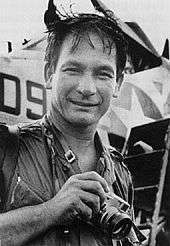Henri Huet

Henri Huet (April 4, 1927 – 10 February 1971) was a French war photographer, noted for his work covering the Vietnam War for Associated Press (AP).
Early life
Huet was born in Da Lat, Vietnam, the son of a Breton engineer and Vietnamese mother. He went to France as a boy of five, was educated at Saint-Malo in Brittany, and studied at the art school in Rennes and began his adult career as a painter. He later joined the French Marine (navy) and received training in photography, returning to Vietnam in 1949 as a combat photographer in the First Indochina War. After discharge from the navy when the war ended in 1954, Huet remained in Vietnam as a civilian photographer working for the French and American governments. While employed by the United States Operation Mission (USOM) photo lab (1955-1960), he enjoyed the mentorship of lab director, Charles E. (Gene) Thomas, who himself had been a combat photographer in WWII. Several of Huet's photos reflect the influence of Thomas's work. He went on to work for United Press International (UPI), later transferring to AP in 1965, covering the Vietnam War.
Photographic career
Huet's photographs of the war were influential in moulding American public opinion. One of his most memorable series of photographs featured Pfc Thomas Cole, a young medic of the First Cavalry division, tending fellow soldiers despite his own wounds. The series of twelve photographs was published in the 11 February 1966 edition of LIFE magazine, with one of the haunting images featuring on the cover. In 1967 the Overseas Press Club awarded Huet the Robert Capa Gold Medal for the "best published photographic reporting from abroad, requiring exceptional courage and enterprise".[1]
Death
On February 10, 1971, during South Vietnam's invasion of southern Laos, known as Operation Lam Son 719, Huet and three other photojournalists, joined the operation commander, Lt Gen Hoang Xuan Lam, on a helicopter inspection tour of the battlefront. The pilots of the South Vietnamese Air Force (VNAF) UH-1 Huey carrying the photojournalists lost their way and flew into the most heavily defended area of the Ho Chi Minh trail, where it and a second chopper were shot down by hidden North Vietnamese 37mm anti-aircraft guns, killing all 11 on the photographers' aircraft and four on the other.
Huet's fellow photographers were Larry Burrows, British, of LIFE magazine, Kent Potter, American, of UPI and Keizaburo Shimamoto, a Japanese freelance photographer working for Newsweek. The crash site was rediscovered in 1996 and in March, 1998, a second search team from the US Joint Task Force Full Accounting (JTFFA), the Pentagon unit responsible for recovering MIA remains in Indochina and elsewhere, excavated the mountainside, finding aircraft parts, camera pieces, 35mm film, along with traces of human remains, which proved too scant for laboratory identification.[2]
On April 3, 2008, a ceremony was held at the Newseum in Washington, D.C. to mark the interment of the remains of Huet, Burrows, Potter and Shimamoto, along with the seven South Vietnamese also killed in the shootdown. Speakers included Richard Pyle, Saigon bureau chief of The Associated Press in Saigon at the time of the crash, and Horst Faas, former AP Saigon photo chief, who were co-authors of Lost Over Laos: A True Story of Tragedy, Mystery, and Friendship, published by Da Capo Press in 2003 and re-released in paperback in 2004. The book recounts the personal stories of the four photographers, the events leading to their deaths, and how Pyle helped the Hawaii-based MIA unit locate the long-lost Laotian crash site in 1996. Pyle and Faas were present when site 2062 was excavated in March 1998. In late 2002, the search unit, renamed the POW/MIA Accounting Command (JPAC), declared the case closed on grounds of circumstantial group identification. After bureaucratic complications blocked efforts to bury the group remains on official ground, the Newseum agreed to accept them and arranged in 2006 for their acquisition from JPAC. The ceremony on April 3, 2008, which preceded the Newseum's own official opening by a week, was attended by more than 100 guests including relatives of Huet, Burrows and Potter, and many former Vietnam War colleagues. Speakers in addition to Pyle and Faas included Newseum president Peter Prichard and AP president Tom Curley, and Burrows' son Russell spoke for the families.
A second book about Huet, titled Henri Huet: J'etais photographe de guerre au Vietnam, was published in Paris in 2006, authored by Helene Gedouin, a senior editor at Hachette Livre publishers of Paris, and Faas, with contributions from Pyle and other former Vietnam colleagues. The story of the shootdown also was told in Requiem, by the Photographers who died in Vietnam and Indochina, edited by Faas and Tim Page, and published by Random House, New York, in 1997.
Among his colleagues covering the war, Huet was respected for his dedication, bravery and skill in the field, and known for his sense of humor and kindness. Dirck Halstead, the Photo Chief of United Press International in 1965, remarked that he "always had a smile on his face".[3]
Work
-

One of Huet's historic series of photographs featuring medic Thomas Cole tending wounded American Soldiers
-

Huet's photograph of Thomas Cole featured on the cover of LIFE magazine
-

Huet's poignant photograph of colleague Dickey Chapelle receiving last rites after being fatally wounded by a landmine in Vietnam.
See also
Notes
- ↑ "The Robert Capa Gold Medal". OPC Awards. Overseas Press Club of America. 2004. Retrieved 2006-06-04.
- ↑ Pyle, Richard (March 22, 1998). "Laos 1971 Crash Scene Searched". Associated press. Retrieved 2006-06-04.
- ↑ Halstead, Dirck (November 1997). "Requiem". Digital Journalist. Retrieved 2006-06-04.
References
- "Requiem - Portrait Of Henri Huet". Retrieved 2006-06-03.
- "Henri Huet, The forgotten Photographer". Archived from the original on 2007-10-07. Retrieved 2006-06-03.
- Raphaël Millet, catalogue of the exhibition Requiem, Singapore, Nanyang Academy of Fine Arts (NAFA), in partnership with Month of Photography Asia, July 2011, pp. 4–5. Remembering Henri Huet, the Young Veteran. ISBN 978-981-08-9097-1.